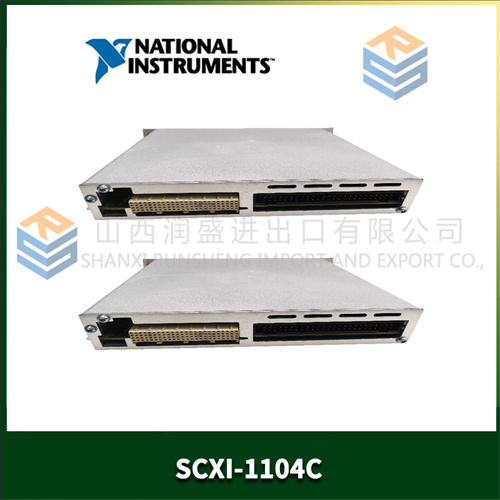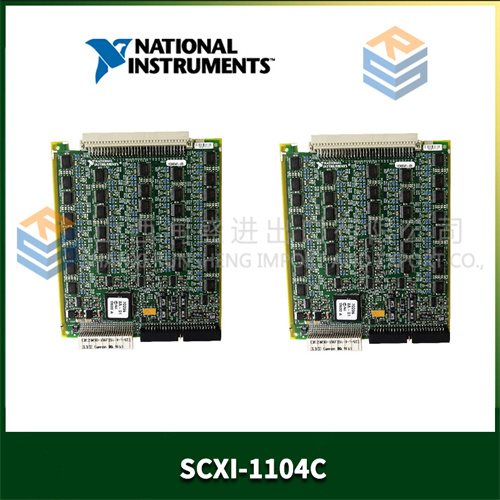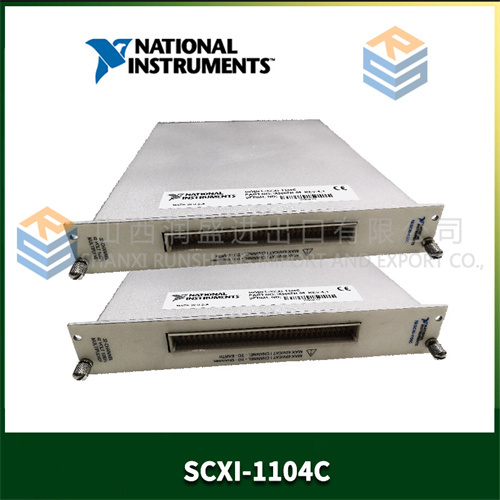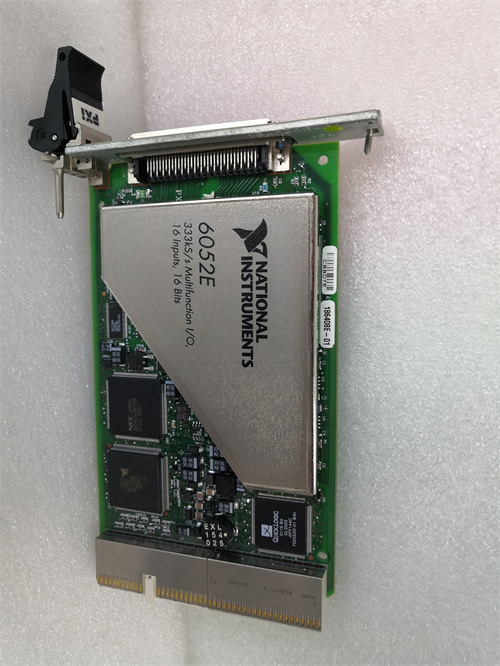Description

1. Product Overview
The SCXI – 1104C is a data acquisition module produced by National Instruments (NI), a well – known company in the field of measurement and automation. SCXI stands for Signal Conditioning eXtensions for Instrumentation, and the 1104C is designed to condition and acquire analog signals from various sensors in industrial and laboratory applications.
2. Key Functions
- Signal Conditioning: One of the main functions of the SCXI – 1104C is to condition raw analog signals from sensors. Sensors often produce weak or noisy signals that need to be amplified, filtered, and isolated before they can be accurately measured by a data acquisition system. For example, if it’s connected to a strain gauge sensor, it can amplify the small voltage changes produced by the strain gauge to a level suitable for measurement.
- Data Acquisition: The module is capable of acquiring the conditioned analog signals and converting them into digital data that can be processed by a computer or other data – handling devices. It can sample the signals at a high rate, allowing for real – time monitoring and analysis of dynamic processes.
- Multichannel Operation: The SCXI – 1104C typically has multiple input channels. This enables it to simultaneously measure signals from multiple sensors, which is useful in applications where multiple parameters need to be monitored, such as in a manufacturing process where temperature, pressure, and vibration need to be measured at different points.

3. Product Parameters
| Parameter | Specification |
|---|---|
| Supply Voltage | Usually operates on a regulated power supply, typically around ±15 VDC. This provides the necessary power for the internal circuitry and signal – conditioning components. |
| Number of Channels | It commonly has 8 differential input channels or 16 single – ended input channels. This flexibility allows it to be configured according to the specific requirements of the application. |
| Input Voltage Range | The input voltage range can be adjusted, typically from – 10 V to + 10 V, – 5 V to + 5 V, – 1 V to + 1 V, etc. This allows it to handle a wide variety of sensor output signals. |
| Sampling Rate | It can achieve a relatively high sampling rate, for example, up to 250 kS/s (kilosamples per second). This high sampling rate is suitable for capturing fast – changing signals. |
| Resolution | The module usually offers a high – resolution analog – to – digital conversion, such as 16 – bit resolution. This high resolution ensures accurate measurement of the analog signals. |
| Bandwidth | The bandwidth of the signal – conditioning circuitry is typically in the range of several kilohertz, which allows it to pass signals of interest while filtering out high – frequency noise. |
| Isolation | It provides electrical isolation between the input channels and the rest of the system. This isolation helps to protect the data acquisition system from electrical interference and potential damage from high – voltage transients. |
| Dimensions | The physical dimensions are designed to fit into the SCXI chassis. It has a compact form factor, making it suitable for installation in a rack – mounted or bench – top setup. |
4. Advantages and Features
- High – Quality Signal Conditioning: The SCXI – 1104C provides excellent signal – conditioning capabilities, which helps to improve the accuracy and reliability of the data acquisition. It can effectively reduce noise and interference, resulting in more precise measurements.
- Flexibility: With its multiple input channels and adjustable input voltage ranges, it can be easily configured to meet the requirements of different applications. Whether it’s measuring low – level signals from thermocouples or high – voltage signals from power sensors, the module can be adapted accordingly.
- Compatibility: It is fully compatible with National Instruments’ data acquisition systems and software. This allows for seamless integration into existing measurement and automation setups, and it can be easily programmed using NI’s programming environments such as LabVIEW.

5. Application Areas
- Industrial Automation: In manufacturing plants, the SCXI – 1104C can be used to monitor and control various processes. For example, it can measure the temperature, pressure, and flow rate of fluids in a chemical process, and the data can be used to adjust the process parameters in real – time.
- Research and Development: In laboratories, it is used for data acquisition in experiments. For instance, in a materials testing laboratory, it can measure the strain and stress of materials under different loads.
- Test and Measurement: It is widely used in test and measurement applications, such as in the automotive industry to test the performance of engines or in the aerospace industry to measure the vibrations of aircraft components.
6. Selection Considerations
- Channel Requirements: Determine the number of input channels you need based on the number of sensors you want to connect. If you have multiple sensors measuring different parameters, choose a module with an appropriate number of channels.
- Input Voltage Range: Consider the range of voltages that your sensors will output. Make sure the module can handle the input voltage range of your sensors without saturation or loss of accuracy.
- Sampling Rate and Resolution: For applications where fast – changing signals need to be measured, a higher sampling rate is required. Similarly, for applications that demand high – precision measurements, a higher – resolution module is preferable.
- Compatibility: Ensure that the SCXI – 1104C is compatible with your existing data acquisition system and software. Check the communication protocols and the programming interfaces.
7. Precautions
- Installation: Follow the installation instructions provided by National Instruments carefully. Ensure proper grounding and wiring to prevent electrical interference and ensure accurate signal measurement.
- Calibration: Periodically calibrate the module to maintain its measurement accuracy. Calibration ensures that the module is providing accurate and reliable data.
- Environmental Conditions: Consider the environmental conditions where the module will be installed. Protect it from extreme temperatures, humidity, and dust, as these can affect its performance and lifespan











Reviews
There are no reviews yet.